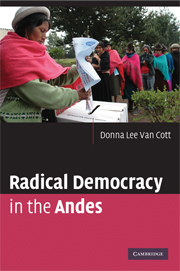Book contents
- Frontmatter
- Contents
- Acknowledgments
- List of Acronyms
- 1 Introduction: The Political and Cultural Origins of Democratic Institutional Innovation
- 2 The Legal and Political Context for Municipal Reform in Bolivia and Ecuador
- 3 Mayoral Leadership and Democratic Institutional Innovation
- 4 Political Parties, Civil Society, and Democratic Institutional Innovation
- 5 Institutional Innovation in Ecuador
- 6 Institutional Innovation in Bolivia
- 7 Conclusion: An Interaction Model of Democratic Institutional Innovation
- References
- Index
5 - Institutional Innovation in Ecuador
Published online by Cambridge University Press: 05 September 2012
- Frontmatter
- Contents
- Acknowledgments
- List of Acronyms
- 1 Introduction: The Political and Cultural Origins of Democratic Institutional Innovation
- 2 The Legal and Political Context for Municipal Reform in Bolivia and Ecuador
- 3 Mayoral Leadership and Democratic Institutional Innovation
- 4 Political Parties, Civil Society, and Democratic Institutional Innovation
- 5 Institutional Innovation in Ecuador
- 6 Institutional Innovation in Bolivia
- 7 Conclusion: An Interaction Model of Democratic Institutional Innovation
- References
- Index
Summary
Within the same legal and macropolitical framework, Ecuadorian municipalities responded differently to the opportunity presented by decentralization and the political ascent of indigenous social movements and their electoral vehicles. In this chapter I describe the evolution of local government institutions in five cantons in which Pachakutik won office in 1996 or 2000. In two, Pachakutik remains in power and presides over what outsiders consider to be “model” radical democratic institutions. In three others, Pachakutik lost power to rival indigenous sectors and leadership cupulas: to the evangelical party Amauta Jatari/Amauta Yuyay in Chimborazo province and to the mestizo party ID in Guaranda. The five case studies presented represent two distinct geographic biopsies of Ecuadorian democracy. The two model cases, Cotacachi and Otavalo, are located contiguously in the northern sierra province of Imbabura. The three more-problematic cases lie contiguously across the two southern sierra provinces of Chimborazo and Guaranda. Comparable socioeconomic statistics for each municipality are presented in Table 5.1.
Despite the lack of top-down diffusion of specific participatory–deliberative or traditional–cultural institutions, some common features may be observed in all five Pachakutik-led municipalities. First, mayors made a great effort to meet with constituents as individuals or in groups. In small, rural, majority-indigenous cantons Pachakutik mayors and councillors engage in considerable face-to-face interaction with indigenous communities. In larger cantons, distant communities are less able to participate directly but receive regular communications in their own language from municipal authorities.
- Type
- Chapter
- Information
- Radical Democracy in the Andes , pp. 134 - 174Publisher: Cambridge University PressPrint publication year: 2008

